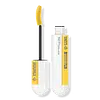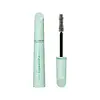Maybelline Volum' Express Colossal Curl Bounce Mascara Versus Covergirl Lash Blast Cleantopia Mascara
What's inside
What's inside
 Key Ingredients
Key Ingredients

 Benefits
Benefits

 Concerns
Concerns

 Ingredients Side-by-side
Ingredients Side-by-side

Water
Skin ConditioningBehenyl Behenate
EmollientStyrene/Acrylates/Ammonium Methacrylate Copolymer
Cetearyl Alcohol
EmollientStearic Acid
CleansingPalmitic Acid
EmollientPoly C10-30 Alkyl Acrylate
Emulsion StabilisingPvp
Emulsion StabilisingVp/Eicosene Copolymer
Aminomethyl Propanediol
BufferingPhenoxyethanol
PreservativeCaprylyl Glycol
EmollientPotassium Cetyl Phosphate
EmulsifyingButylene Glycol
HumectantMyristic Acid
CleansingSodium Laureth Sulfate
CleansingTetrasodium EDTA
Silica
AbrasivePotassium Sorbate
PreservativeCI 77491
Cosmetic ColorantCI 77492
Cosmetic ColorantCI 77499
Cosmetic ColorantCI 77007
Cosmetic ColorantCI 77891
Cosmetic ColorantMica
Cosmetic ColorantCI 77742
Cosmetic ColorantCeramide AP
Skin ConditioningWater, Behenyl Behenate, Styrene/Acrylates/Ammonium Methacrylate Copolymer, Cetearyl Alcohol, Stearic Acid, Palmitic Acid, Poly C10-30 Alkyl Acrylate, Pvp, Vp/Eicosene Copolymer, Aminomethyl Propanediol, Phenoxyethanol, Caprylyl Glycol, Potassium Cetyl Phosphate, Butylene Glycol, Myristic Acid, Sodium Laureth Sulfate, Tetrasodium EDTA, Silica, Potassium Sorbate, CI 77491, CI 77492, CI 77499, CI 77007, CI 77891, Mica, CI 77742, Ceramide AP
Water
Skin ConditioningParaffin
PerfumingStearic Acid
CleansingPvp
Emulsion StabilisingCetyl Alcohol
EmollientCera Microcristallina
Emulsion StabilisingHydrogenated Vegetable Oil
EmollientArginine
MaskingPolysorbate 20
EmulsifyingPropylene Glycol
HumectantRhus Verniciflua Peel Wax
Copernicia Cerifera Cera
Emollient2,3-Butanediol
HumectantStearyl Stearate
EmollientSynthetic Wax
AbrasivePanthenol
Skin ConditioningCandelilla Cera
EmollientCaprylyl Glycol
EmollientHectorite
AbsorbentSimethicone
EmollientSilica
AbrasiveTocopheryl Acetate
AntioxidantKaolin
AbrasivePantolactone
HumectantArgania Spinosa Kernel Oil
EmollientCamellia Sinensis Seed Oil
HumectantCellulose
AbsorbentPassiflora Edulis Seed Oil
EmollientRicinus Communis Seed Oil
MaskingSclerocarya Birrea Seed Oil
HumectantSimmondsia Chinensis Seed Oil
EmollientCocos Nucifera Oil
MaskingCaprylic/Capric Triglyceride
MaskingPersea Gratissima Oil
Skin ConditioningBiotin
AntiseborrhoeicCeramide Ng
Skin ConditioningChamomilla Recutita Flower Extract
MaskingCucumis Sativus Fruit Extract
EmollientAloe Barbadensis Leaf Extract
EmollientTocopherol
AntioxidantIron Oxides
CI 77007
Cosmetic ColorantWater, Paraffin, Stearic Acid, Pvp, Cetyl Alcohol, Cera Microcristallina, Hydrogenated Vegetable Oil, Arginine, Polysorbate 20, Propylene Glycol, Rhus Verniciflua Peel Wax, Copernicia Cerifera Cera, 2,3-Butanediol, Stearyl Stearate, Synthetic Wax, Panthenol, Candelilla Cera, Caprylyl Glycol, Hectorite, Simethicone, Silica, Tocopheryl Acetate, Kaolin, Pantolactone, Argania Spinosa Kernel Oil, Camellia Sinensis Seed Oil, Cellulose, Passiflora Edulis Seed Oil, Ricinus Communis Seed Oil, Sclerocarya Birrea Seed Oil, Simmondsia Chinensis Seed Oil, Cocos Nucifera Oil, Caprylic/Capric Triglyceride, Persea Gratissima Oil, Biotin, Ceramide Ng, Chamomilla Recutita Flower Extract, Cucumis Sativus Fruit Extract, Aloe Barbadensis Leaf Extract, Tocopherol, Iron Oxides, CI 77007
 Reviews
Reviews

Ingredients Explained
These ingredients are found in both products.
Ingredients higher up in an ingredient list are typically present in a larger amount.
Caprylyl Glycol is a humectant and emollient, meaning it attracts and preserves moisture.
It is a common ingredient in many products, especially those designed to hydrate skin. The primary benefits are retaining moisture, skin softening, and promoting a healthy skin barrier.
Though Caprylyl Glycol is an alcohol derived from fatty acids, it is not the kind that can dry out skin.
This ingredient is also used as a preservative to extend the life of products. It has slight antimicrobial properties.
Learn more about Caprylyl GlycolThis pigment is called Ultramarine blue lazurite. It gives a saturated blue color, but can be used to create other colors as well.
According to the manufacturer, it is usually made from kaolin, sodium sulfate, sodium carbonate, sulfur, and charcoal.
Pvp is a water-soluble synthetic polymer and common hairstyling ingredient. It is a film-forming ingredient and used to "hold" specific shapes of hair.
Pvp is less effective in high-humidity. It tends to draw moisture, but this moisture dismantles the structure and "hold".
Silica, also known as silicon dioxide, is a naturally occurring mineral. It is used as a fine, spherical, and porous powder in cosmetics.
Though it has exfoliant properties, the function of silica varies depending on the product.
The unique structure of silica enhances the spreadability and adds smoothness, making it a great texture enhancer.
It is also used as an active carrier, emulsifier, and mattifier due to its ability to absorb excess oil.
In some products, tiny microneedles called spicules are made from silica or hydrolyzed sponge. When you rub them in, they lightly polish away dead skin layers and enhance the penetration of active ingredients.
Learn more about SilicaStearic Acid is a fatty acid. It is an emollient, emulsifier, and texture enhancer.
As an emollient, stearic acid helps soften skin. It aids the skin's protective barrier by preventing water loss. It also provides a gentle cleansing effect without stripping away natural oils.
Stearic acid may also be used to enhance the texture of products. It can add volume and stabilize ingredients such as water and oil. This can help water and oil ingredients from separating.
Sources of stearic acid include animal or vegetable fats/oils such as coconut or shea. It can be naturally found in butter, cocoa butter, shea butter, vegetable fats, and animal tallow.
This ingredient may not be Malassezia folliculitis, or fungal-acne safe.
Learn more about Stearic AcidWater. It's the most common cosmetic ingredient of all. You'll usually see it at the top of ingredient lists, meaning that it makes up the largest part of the product.
So why is it so popular? Water most often acts as a solvent - this means that it helps dissolve other ingredients into the formulation.
You'll also recognize water as that liquid we all need to stay alive. If you see this, drink a glass of water. Stay hydrated!
Learn more about Water